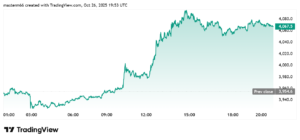Bitcoin’s Low Volatility: Implications for Saylor’s Strategy and BTC Value
Introduction
Bitcoin (BTC), the pioneering cryptocurrency, has recently experienced a period of notably low volatility. While this may seem like a positive development, it poses unique challenges for entities like Strategy (formerly MicroStrategy), particularly as they navigate the complexities of acquiring more Bitcoin. As institutional interest in Bitcoin rises, driven by the advent of exchange-traded funds (ETFs) and corporate treasuries, the implications of this low volatility beckon a closer inspection. This article explores how the current landscape could affect Mike Saylor’s strategy and the broader Bitcoin market.
Impact of Low Volatility on Saylor’s Strategy
Michael Saylor’s Strategy has predominantly funded its Bitcoin purchases through convertible debt and equity offerings. Historically, higher volatility increased the value of embedded call options within these convertible debts, enabling Strategy to leverage its position in Bitcoin more advantageously. However, the current trend of diminishing volatility hampers Saylor’s ability to scale up Bitcoin holdings, as the attractiveness of these debt options declines. Analysts, like Alex Kruger, assert that the era of MSTR effectively pushing BTC prices higher may have come to an end, potentially signaling a shift in market dynamics.
Consequences for BTC Value
The ramifications of low volatility extend beyond Saylor’s immediate strategy; they may also impact Bitcoin’s overall market value. The decline in demand for convertible debt translates into less favorable terms for financing Bitcoin purchases, which could stifle further accumulation strategies. Analysts from Coinbase have issued warnings that this cautious sentiment could manifest in the short term, particularly as larger players remain sidelined, leading to a fragile market environment. The enhanced institutional presence in the market, while beneficial in terms of long-term adoption, may inadvertently contribute to hesitancy among larger players as they grapple with the less favorable investment landscape.
Demand from Digital Asset Treasury Companies (DATs)
The demand for Bitcoin from Digital Asset Treasury Companies (DATs) has also shown signs of weakness. Reports indicate that subsequent to a brief resurgence in activity in August, demand from DATs has largely evaporated. Current levels of engagement reveal a narrowing focus on Ethereum (ETH) rather than Bitcoin, raising concerns about the markets’ short-term recovery. This declining demand from significant players serves as a critical indicator of market health and investor confidence in Bitcoin’s immediate future.
Market Implications and Recovery Prospects
Given the current state of play, it becomes increasingly important to evaluate Bitcoin’s market performance amid these challenges. With a marginal recovery noted post the $21K overhaul in July, Strategy’s accumulation efforts appear to be stalling in the latter half of the year. Coinbase analysts suggest that this fading demand and the lack of participation from major institutional players could pose risks for Bitcoin in the near term. Analysts emphasize the fragility of the market, advocating for cautious positioning among investors as the leading players remain on the sidelines.
Possible Future Scenarios for Bitcoin
Should the trend of low volatility persist, Saylor’s Strategy may resort to relying more heavily on equity offerings to fund future Bitcoin acquisitions. However, the recent drop in the market net asset value (mNAV) for Bitcoin holdings, currently sitting at 1.1X, brings additional complications. If this metric were to slip below 1, it could trigger further issues for stock sell-off capital raising initiatives, further complicating Saylor’s approach to building Bitcoin reserves.
Conclusion
In summary, while lower volatility in Bitcoin may create a semblance of stability, it poses significant challenges for Michael Saylor’s Strategy and the broader market. This dynamic disrupts traditional financing methods and impacts the eagerness of institutional players to continue accumulating Bitcoin. As such, it is crucial for investors and market participants to remain vigilant amid these evolving conditions as the Bitcoin landscape continues to unfold.
















